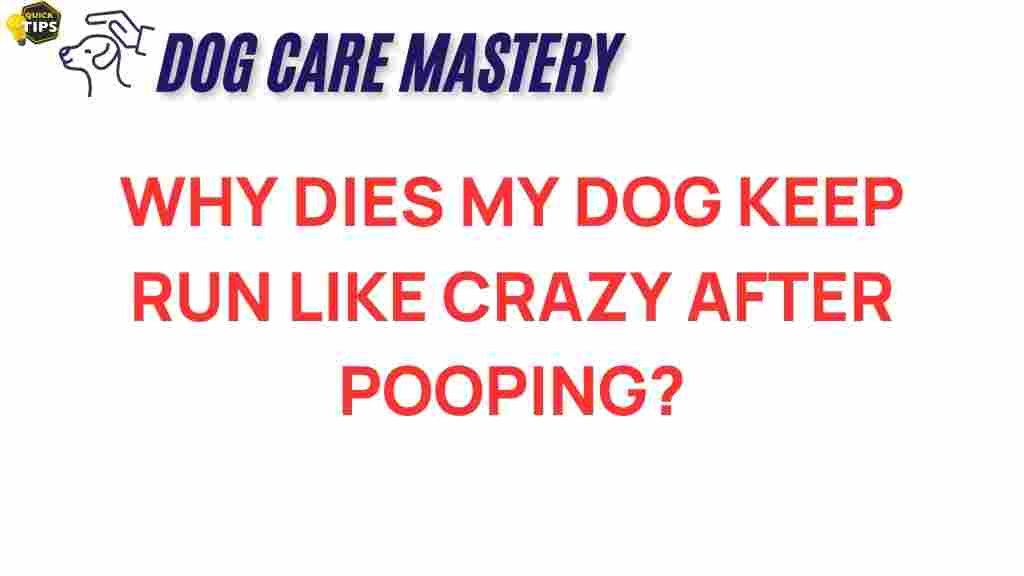Understanding Dog Behavior: Why Your Dog’s Post-Poop Zoomies Might Surprise You
As a dog owner, you may have experienced the delightful and often amusing spectacle of your furry friend taking off in a burst of energy right after doing their business. These post-poop zoomies can leave you scratching your head and wondering about the underlying reasons behind this quirky dog behavior. In this article, we will explore the fascinating world of canine antics, dissect the reasons for these zoomies, and offer insights into what they mean for your pup’s health and happiness.
What Are Post-Poop Zoomies?
Post-poop zoomies, often referred to as “the zoomies,” are characterized by a sudden and exuberant burst of energy from your dog shortly after they relieve themselves. This behavior can include running in circles, darting back and forth, and even playful jumping. While it may seem odd, this is a common occurrence among dogs of all ages and breeds.
Why Do Dogs Experience Zoomies?
The reasons behind your dog’s post-poop zoomies are varied and can be attributed to several factors related to their natural instincts and overall well-being. Here are some of the primary reasons:
- Relief and Release: After a bowel movement, dogs often feel a sense of relief. This newfound lightness can lead to an energetic release as they celebrate their comfort.
- Instinctual Behavior: In the wild, dogs would often leave their waste in a specific area and quickly move away from it to avoid attracting predators. The zoomies may be a remnant of this instinctual behavior.
- Playfulness: Dogs are naturally playful creatures. The act of relieving themselves can trigger a playful response, leading to zoomies as a way to express their happiness.
- Excitement: The act of going outside and exploring new scents and sounds can excite dogs. Once they finish their business, this excitement often translates into a burst of energy.
- Social Interaction: If your dog has friends or family members around, they might engage in zoomies as a form of social play, inviting others to join in on the fun.
The Connection Between Dog Behavior and Health
Understanding your dog’s post-poop behavior is crucial not just for amusement but also for gauging their overall health. Here’s how to connect the dots between zoomies and your dog’s well-being:
- Normal Behavior: For most dogs, post-poop zoomies are a normal behavior and indicate a healthy and happy pet.
- Watch for Changes: If your dog suddenly stops their zoomies or shows signs of discomfort after pooping, it might be worth consulting a veterinarian.
- Monitor Diet: Dietary changes can impact your dog’s bowel movements. A well-balanced diet can lead to healthy pooping and, consequently, happy zoomies!
Step-by-Step Process: Encouraging Healthy Dog Behavior
To ensure your dog can enjoy their zoomies safely and positively, consider the following steps:
- Regular Exercise: Ensure your dog gets plenty of physical activity. Regular walks and playtime can help channel their energy effectively.
- Consistent Bathroom Schedule: Establish a routine for bathroom breaks. Consistency helps your dog learn when it’s time to go out, which can lead to more predictable zoomies.
- Positive Reinforcement: Reward your dog with praise or treats when they exhibit good behavior after pooping, encouraging them to associate bathroom breaks with positive outcomes.
- Safe Space: Create a safe area for post-poop zoomies. Ensure the space is free of hazards, allowing your dog to unleash their energy without risk.
- Interactive Play: Engage your dog in games that stimulate their mind and body. This can help reduce the intensity of zoomies while still allowing them a release of energy.
Troubleshooting Zoomies: When to Be Concerned
While post-poop zoomies are generally harmless, there are instances when they may indicate underlying issues. Here are some troubleshooting tips:
- Excessive Zoomies: If your dog seems to be having uncontrollable zoomies that lead to destructive behavior, it may be a sign of pent-up energy or anxiety.
- Change in Behavior: A sudden change in your dog’s zoomie pattern could indicate stress or discomfort. Monitor your dog’s behavior for other signs of distress.
- Physical Symptoms: If your dog shows signs of pain or discomfort (such as whining or limping) after pooping, it might be worth consulting a veterinarian.
If you notice concerning changes in your dog’s behavior, don’t hesitate to seek professional advice. For more information on dog health, you can visit the AKC’s health resources.
Fun Facts About Dog Behavior and Zoomies
Here are some fun facts that might surprise you about dog behavior related to zoomies:
- Not all dogs experience zoomies, and it can vary between breeds. High-energy breeds like Border Collies and Jack Russell Terriers are more likely to exhibit this behavior.
- Zoomies can occur at any time, not just after pooping. Dogs can also get the zoomies after baths, during playtime, or even in the middle of the night!
- Some dogs are known to perform “victory laps” after a successful bathroom break, which can be both entertaining and endearing.
Conclusion: Embracing Your Dog’s Unique Behavior
Understanding your dog’s post-poop zoomies is an essential part of being a responsible pet owner. These bursts of energy are typically a sign of happiness, relief, and playfulness. By fostering an environment that encourages healthy dog behavior, you can ensure your furry friend enjoys their zoomies in a safe and positive way. Remember, each dog is unique, and their behaviors are often reflections of their personalities and instincts.
So, the next time you witness those delightful post-poop zoomies, embrace the joy and excitement they bring! If you’re looking for more insights into dog behavior, check out our other articles here to enhance your understanding of your four-legged friend.
This article is in the category Behavior and created by dogcaremastery Team
